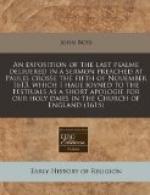[Sidenote fh: Psal. 86. 12.]
[Sidenote fi: Psal. 111. 1.]
[Sidenote fk: Caluin. Genebrard. in loc.]
[Sidenote fl: Galat. 3. 29.]
[Sidenote fm: Psalm. 148.]
[Sidenote fn: Iohn 8. 39.]
[Sidenote fo: Gen. 15. 6. Rom. 4. 3.]
[Sidenote fp: Genebrard.]
1. Dauid inuiteth all the Citizens of heauen, O praise God in his sanctuarie, praise him in the firmament of his power.
2. All the dwellers vpon earth, praise him in the sound of the trumpet, praise him vpon the lute and harpe, &c.
3. Both and all, let euery thing that hath breath, euery thing which hath either the life of nature, or of grace, or of glorie, let euery spirit [fq]whether it be terrestriall or celestiall, of whatsoeuer condition, age, sexe, praise the Lord.
[Sidenote fq: Placidus parmensis & Bellarmin. in loc.]
It is a [fr]_Rabbinical_ conceit that this hymne consists of 13. Halleluiahs, answering 13. Properties of God mentioned Exod. 34. 6.7. verses, and in that our Prophet after a dozen Halleluiahs hath not done, but addeth a thirteenth, hee doth insinuate that when all our deuotion is finished, it is our dutie to begin againe with Gods praise, for as [fs]of him, and thorough him, and for him, are all things, euen so to him is due all glorie for euermore: as his mercies are from euerlasting to euerlasting, from euerlasting election, to euerlasting glorification: so likewise his praises are to bee sung for euer and euer. In this life we begin this hymne singing (as musitians speake) in breifs and semibriefs a staffe or two, but in the world to come standing before the throne of the Lambe, clothed in long white robes, accompanied with all the sweet voyces of heauens incomparable melodious quire: we shall eternally sing, [ft]_Holy, holy, holy, Lord God almightie, which was, and which is, and which is to come, [fu]praise, and glorie, and wisdome, and power, and might, be vnto our God for euermore._ Amen.
[Sidenote fr: Genebrard.]
[Sidenote fs: Rom. 11. 36.]
[Sidenote ft: Apocalip. 4. 8.]
[Sidenote fu: Apocalip. 7. 12.]
FINIS.
* * * * * * * * * * * * * *
[Notes and Errata
In the Latin words “Coelo” and “Coena”, the letter combination “oe” was printed in single-letter (ligature) form, analogous to ae for ae.
The titles “Mr.” and “Dr.” were printed with superscript r, properly transcribed M^{r}. and D^{r}. They have been simplified for readability.
Years are always printed with following period (full stop), regardless of place in the sentence.
Sidenotes—here equivalent to footnotes—were labeled sequentially a-z, repeating as often as necessary. For this e-text they have been given unique identifiers adding a, b, c... to successive series. Note that the 23-letter alphabet has no j, v or w.




